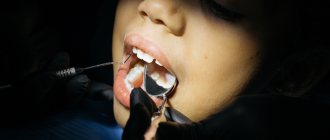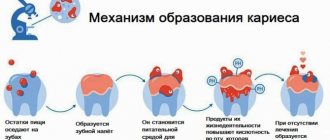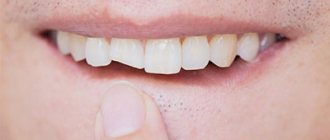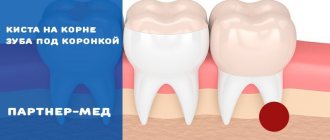Before
After
When there is no trace left of the dental crown, and all the roots are in place, a fair question arises: what to do next? Should this tooth be considered completely lost, or does the presence of the root provide a chance for restoration? Modern dentists, in the fight for every saved tooth, offer several options for solving this problem. The main thing is to make sure that the roots are healthy, there are no cysts, granulomas, inflammatory or carious formations on them.
When is a tooth root 100% subject to extraction?
Tooth root removal is performed if:
- the root is softened below the gum level,
- the root of the tooth is below the level of the surrounding bone tissue,
- the root of the tooth has cracks
:
- the root of the tooth is chipped
:
- the root of the tooth is severely damaged, for example as a result of canal treatment with resorcinol
:
- There are various inflammatory processes around the root and under the root of the tooth - cyst, cystogranuloma
:
- the root of the tooth is mobile,
- there is a deep dental pocket.
Tooth extension with veneers
Veneers are thin plates that are fixed to the outer surface of the tooth.
What defects will veneers hide:
- Erased tooth enamel;
- Small chips;
- Cracks;
- Darkened fillings;
- Stains on enamel;
- Tooth relief.
With the help of veneers, the surface of your front teeth will become flawless. High-quality material is not subject to color change under the influence of food coloring.
Disadvantages of use:
- The need to grind the tooth;
- A smile that is too beautiful raises doubts about its naturalness.
How is tooth root removal done?
Are there any features or important points when removing a tooth root? Of course, any removal - be it tooth extraction, wisdom tooth removal, impacted tooth or tooth root should be carried out as atraumatically as possible, preserving the tissue structure
that surround a tooth or tooth root:
The goal of atraumatic root removal is to preserve bone
. Removal should be done painlessly.
The clinics of the German Implantology Center are supporters of atraumatic and painless removal. Our technologies have been proven over the years, and our patients feel very comfortable with them. It is no secret that many patients have fears about removal, and these fears sometimes postpone the surgical stage of treatment for a long time. In our clinics, we help patients overcome these fears. The patient may not be afraid of anything - both in the case of a single extraction and in case of multiple extractions of teeth
:
Price
- Primary appointment (examination, consultation) with a dentist (special offer) 100001
For free
Promotion
- Restoring a tooth with a filling (Restoration) 140007
6 900 ₽
- Tooth restoration with filling materials using anchor/fiberglass pins (restoration) 140009
8 900 ₽
- Tooth restoration with inlay (E.max) 152012
19 900 ₽
- Tooth restoration with a crown (E.max) 152013
21 900 ₽
- Tooth restoration with Veneer, Half-crown (E.max) 152014
21 900 ₽
- Tooth restoration with a full zirconium crown 152015
13 900 ₽
- Tooth restoration with a metal-ceramic crown 152019
13 900 ₽
Teeth extension is aimed at restoring their anatomical shape and color. Used for chips, cracks, and changes in enamel shade. Allows you to correct congenital dental anomalies and eliminate interdental gaps. Methods and materials for extensions are selected depending on the type of defect. These can be composite restorations, installation of pins, inlays, veneers or crowns. The chosen option affects the cost of treatment.
What is atraumatic tooth root removal?
What instruments does the surgeon use to achieve atraumaticity? For atraumatic removal, special instruments are used - thin, neat and elastic elevators that can minimally invasively penetrate and expand the periodontal tissue that connects the tooth root directly to the jaw. Using special instruments, the periodontal ligaments are cut so that the root can be removed as carefully as possible, in its “pure form.”
The vestibular plate that surrounds the bone is very thin. And we work with her carefully when removing teeth. It may also be necessary to saw the root of the tooth so that it can be removed in pieces. Sawing can be carried out with oscillating ultrasonic attachments - ultrasonic knives. Cutting the root of a tooth can be done quite effectively with a high-quality thin surgical dental bur, which has a certain length.
After cutting the root, the medial wall of the root is first removed, and then the vestibular wall of the root is removed. This allows for maximum preservation of surrounding tissue.
Then, after such removal, you can preserve the tooth socket or place an implant so that the bone is preserved as much as possible. Preservation of the tooth socket is carried out if there are no conditions for installing an implant at once, or if the patient undergoes delayed implantation.
If the roots of wisdom teeth are removed, the socket is not preserved; it is enough to remove them as atraumatically as possible. Let's talk about this in a little more detail.
Features of root removal of decayed wisdom teeth
Are there any difficulties when removing the roots of wisdom teeth? Removing the roots of wisdom teeth requires that the surgeon has sufficient experience. Often the roots of these third molars (wisdom teeth) are located close to the mandibular canal. Often the roots of molars are adjacent to the upper or lateral wall of the mandibular canal. The configuration of wisdom tooth roots is extremely diverse and sometimes extremely difficult to remove:
Therefore, when removing the roots of wisdom teeth, it is imperative that the patient undergo a CT scan. And the surgeon, as I said, needs to have some experience in surgical training in order to avoid the risks of removing the roots of such teeth and carry out the manipulation as efficiently as possible.
Like any root teeth, the roots of wisdom teeth are removed by cutting them along the roots. Wisdom teeth do not have problems because they are close to the angle of the lower jaw and there are strong cortical plates there. When I talked about thin vestibular walls, this comparison refers to the aesthetic zone of the smile, to the frontal group of teeth, including the premolars:
.
Symptoms
The patient cannot always see the preserved fragments and fragments of the tooth root. If they are severely damaged, they may be hidden by gum tissue. If the pathological process continues, symptoms occur:
- aching pain occurs in the area of a fallen or damaged tooth in the gum;
- when pressing on the problem area, sharp pain occurs;
- the gums swell, increase in volume, may turn red, and tissue may grow near the socket;
- bleeding appears at the site of the destroyed crown (spontaneous or due to mechanical impact);
- suppuration occurs and the temperature rises.
If any of these symptoms appear, you should immediately consult a dentist. They indicate a complicated inflammatory process. Without treatment, it can cause serious complications, including blood poisoning. Even if there are no symptoms described, tooth decay or collapse of the walls of the crown is a reason to urgently consult a doctor and undergo an x-ray.
Do you have questions about tooth extraction?
We will call you back within 30 seconds
+7
What the patient needs to understand before root removal
You need to assess the health risks, you need to talk to the attending surgeon, find out about his experience. Quite often, tooth root removal is carried out, unfortunately, with the following negative consequences:
- gums are torn
- fractured bony vestibular plate
Sometimes when visiting such patients, you get the feeling that the tooth was not removed, but knocked out with something. There were cases when a patient’s extraction began in some clinic, and there, in the middle of the patient’s appointment, the doctor announced that he was unable to remove it, and the patients came to us in this form to remove the root of a tooth that was already in the extraction stage.
When removing the roots of wisdom teeth, you may face risks such as jaw fracture. One of the common risks of removing the roots of 3 molars is damage to the mandibular nerve
, leading to cuts and numbness in areas of the jaw. There is a risk of damaging the artery on the lingual side.
If, when a tooth is removed, a root or part of it is left behind, what should you do?
According to Russian treatment standards, the tooth root cannot be left during extraction. That is, if the patient was left with a root or part of it during removal, then this is considered a poorly performed surgical procedure.
In European countries there are doctors who agree that if there is no inflammation on the tooth and if the root part is not infected, and removal of the root leads to trauma, then only the cortical part of the root is removed, and the other part remains in the bone.
If the patient is left with a part of the root that is infected, then this is a problem. A cyst may develop and inflammation may develop. If the apical part was not infected, then everything heals and does not bring any trouble to the patient.
Tooth root without crown part
Can a tooth root without a crown cause inflammation in the gums or bone? Of course it can. There is a canal at the root of the tooth; if this canal is infected, then the problem will develop into a negative prognosis.
Inflammation, suppuration, periostitis, osteomyelitis - diseases can develop due to an infected tooth root. And the source of infection at the root must be removed; if it is impossible to remove the infection and preserve the root, then it must be removed.
Is extension on a pin promising?
Of course, it is impossible to call the tooth extension procedure unpromising. This technique is constantly being improved, new technologies are being proposed that impress with their minimal trauma and safety for the patient. This relatively new practice is the installation of fiberglass pins.
Design of fiberglass pins "Rebilda Post" and pins from Russian manufacturers
Creating the final root canal configuration using a calibration drill
Calibration drill versus reamer
After processing the channel with a calibration drill
Silanization of the pin
Application of Futurabond DC adhesive using microbrushes
Restoration of the crown part of the tooth
Fiberglass pins are distinguished by their special plasticity, and this is really important, because the process of splitting the tooth root must be prevented, and the elasticity of the tooth contributes to this. Most often, fiberglass pins are installed in chewing teeth, since they bear the main, cantilever loads during food intake.
RelyX™ Fiber Post
The patient has the right to find out which pin will be installed, what determines the doctor’s choice, and how the extension procedure will take place. The doctor warns the patient about possible complications and talks about what needs to be done to prevent these complications from occurring.
Successful treatment!
Is implantation possible after tooth root removal?
Yes, of course it is possible. And we at the clinics of the German Implantology Center widely use implantation after tooth root removal. Our conditions allow us to carry out implantation in such cases. And if we can achieve primary stability of the implant, then in 90% of cases
After removal, we immediately install the implant. We have rolled out the technology to perfection and gives excellent results.
Of course, with the exception of wisdom teeth, no implant is placed after their removal. But, by the way, wisdom teeth in this situation can be extremely useful, since they... can be transplanted to the place of the problem tooth being removed! Dental transplantation has been practiced in the clinics of the German Implantology Center since 2017, and our specialists have accumulated a wealth of clinical experience. Let's talk about this a little more.
Which is better - filling or crown?
Each method has its advantages. The choice regarding a crown or tooth extension in each clinical situation depends on the degree of destruction, the condition of the root system and periodontal tissues.
For small defects, it is advisable to use composite extensions. If a part of the tooth breaks off or is completely destroyed, it would be better to install a crown. Restoration with filling material is more financially profitable, but to make the final decision - to install a crown or build up a tooth, the indications are taken into account.
An alternative to implantation is autotransplantation of wisdom teeth
Don't rush to remove your wisdom teeth. Firstly
, there must be clear indicators for their removal.
Secondly
, you don’t need to follow fashion, trends and delete eights just because “a girlfriend or friend deleted them and it’s cool.” There are a number of moments in life when wisdom teeth come to our aid.
It is not for nothing that nature has created a number of organs that duplicate each other in our body, for example, we have two lungs, two kidneys, which in case of problems with one lung/kidney come to our aid. Also with wisdom teeth: if a person (for some reason) has problems with the chewing group of teeth, for example, caries has destroyed the sixth or seventh tooth, then eights can come to the rescue. How so? After all, wisdom teeth are not involved in the chewing process. Yes, you are right here. But a wisdom tooth can serve as a donor, and it can be transplanted into place of a tooth with destroyed roots. Fantastic? No, advanced technologies in dentistry. This is called autotransplantation.
In the following video we show in detail the dental transplant surgery. The roots of two sixths of the patient's teeth had just been destroyed, and they were replaced by the patient's own wisdom teeth. And, by the way, this patient at the end of the video gives a detailed review after 1 year after the operation. Look, this is useful:
Correction with crowns
If the tooth is severely damaged, but the root is not destroyed, correction with crowns is used. The technique is implemented on the front and chewing teeth. Crowns are installed when it is impossible to install a filling - when the carious cavity is too extensive, when the tooth is destroyed by 70% or more.
How to install a crown:
- The tooth is prepared, freed from affected tissue, and the walls are ground down;
- An impression is made and sent to the dental laboratory.
- The finished crown is tried on and installed.
Modern technologies make it possible to obtain crowns that perfectly imitate the transparency, shade and texture of natural teeth.
How to care for your teeth after crowns are installed
The basis of care is hygiene. You should brush your teeth at least twice a day, use dental floss and special rinses. Carefully removing all food debris will preserve your oral health for a long time. A timely visit to the dentist is also a must. Inspections must be performed at least twice a year. If something bothers you, a tooth begins to ache, or soft tissue inflammation occurs, this is a reason to visit a dentist or prosthetist as soon as possible. If problems are detected at the very beginning, it will be much easier to fix.
Author:
Mayorov Andrey Mikhailovich
Specialization:
orthopedic dentistry, dental prosthetics, implant installation
Advantages of dental restoration with crowns
Crowns have a number of advantages:
- The installation of such dentures protects the tooth from further destruction much better than a conventional filling on a pin.
- The crowns are very durable and can withstand loads that are significantly more intense than when chewing food.
- Unlike filling material, crowns do not change color during use and do not suffer from food acids and other substances.
- A correctly manufactured and installed crown will allow the damaged tooth to be used for many years to come.
Are modern technologies used when restoring teeth?
A new product that has fundamentally improved the quality of dental restoration is 3D models of dentures. Today, a specialist carries out all the preparatory work on a computer: in a special program he creates a three-dimensional model of the prosthesis, which will subsequently be manufactured on a machine. Thanks to this, the accuracy of work has increased and, accordingly, time for fitting and fitting is saved. Prostheses that are ideal for the patient are manufactured in the clinics of the Unident network without unnecessary visits to the doctor, which distracts the patient from important matters.











